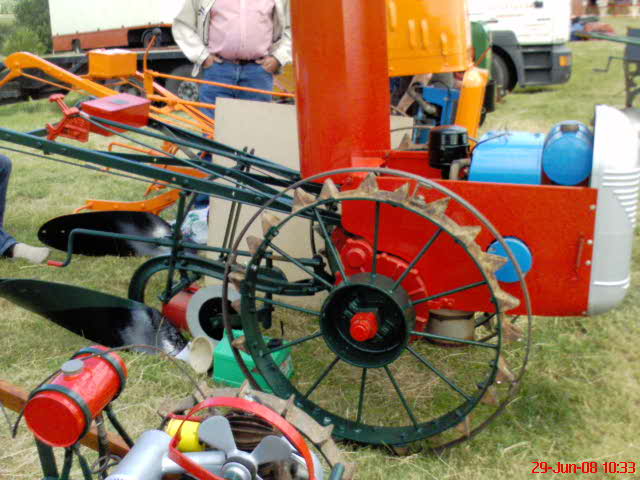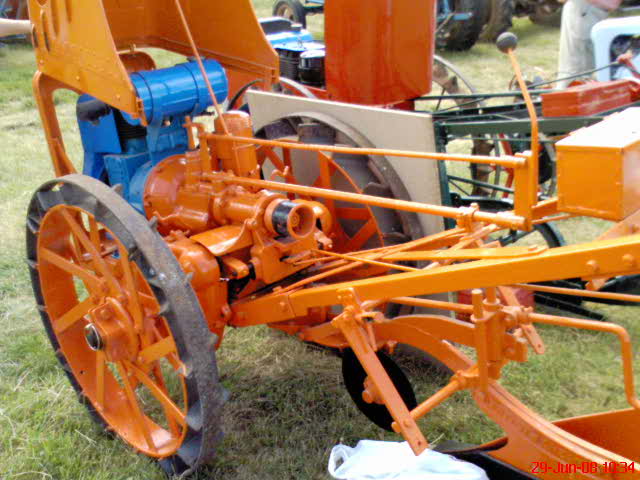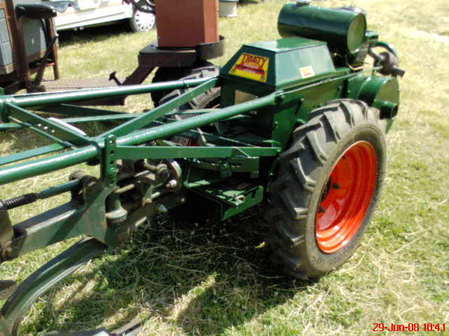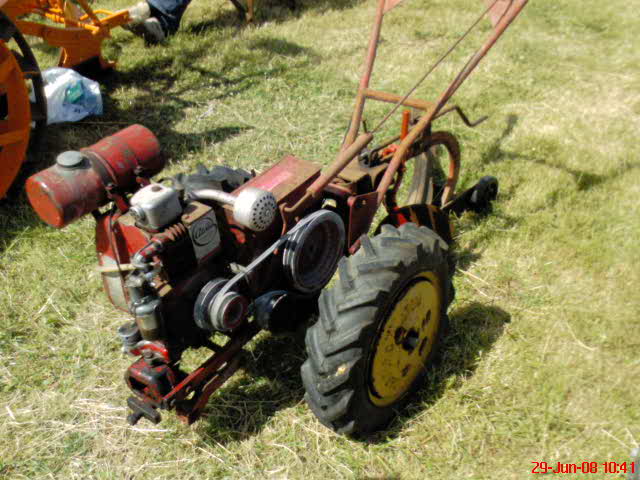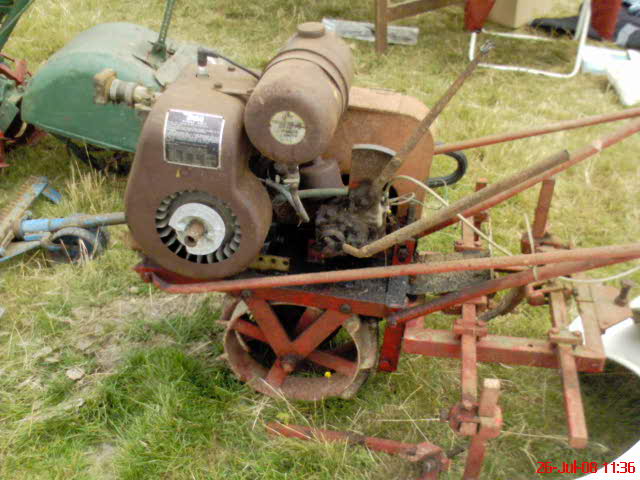Vintage rotovators, tillers and cultivators - great British engineering for the allotment and smallholding.
By Kirsty Cato. All photo's courtesy of Kirsty Cato.
British Anzani
The Anzani Iron Horse two-wheeled tractor was introduced in 1940.
Advertised as ‘the agricultural machine built with aero engine accuracy’ it was fitted with a 4 stroke 6hp Anzani/JAP engine giving a top speed of 4 mph. A centrifugal clutch, three forward gears and reverse and with adjustable track from 24" to 36", a range of steel wheels, extension rims, pneumatic tyres or crawler track options meant it really was a machine to tackle any terrain. You could also purchase a ride-on carriage for the driver turning it into a normal tractor capable of pulling farm carts with up to a ton load.
A range of accessories increased its functionality with attachments for mowing, ploughing, spraying, hoeing, crop lifting and harrowing. It also had a multifunctional belt driven power take-off system which provided farmers with additional tools that were continually developed and added to over the years. Uses included saws, concrete mixers, pumps and generators.
These popular machines proved robust and reliable in use and sold in thousands all around the world. They cost £140 in 1940. Production of agricultural tractors stopped in 1956.
The Anzani Iron Horse two-wheeled tractor was introduced in 1940.
Advertised as ‘the agricultural machine built with aero engine accuracy’ it was fitted with a 4 stroke 6hp Anzani/JAP engine giving a top speed of 4 mph. A centrifugal clutch, three forward gears and reverse and with adjustable track from 24" to 36", a range of steel wheels, extension rims, pneumatic tyres or crawler track options meant it really was a machine to tackle any terrain. You could also purchase a ride-on carriage for the driver turning it into a normal tractor capable of pulling farm carts with up to a ton load.
A range of accessories increased its functionality with attachments for mowing, ploughing, spraying, hoeing, crop lifting and harrowing. It also had a multifunctional belt driven power take-off system which provided farmers with additional tools that were continually developed and added to over the years. Uses included saws, concrete mixers, pumps and generators.
These popular machines proved robust and reliable in use and sold in thousands all around the world. They cost £140 in 1940. Production of agricultural tractors stopped in 1956.
A pair of beautifully restored examples of a Iron Horse seen at Country Fair
Reference http://www.britishanzani.co.uk/HISTORY3.htm
Reference http://www.britishanzani.co.uk/HISTORY3.htm
Trusty Tractors
The Trusty 2-wheeled tractor was built from 1933 to the late 1950s. The basic design was the same but numerous upgrades changes occurred. The basic design had a front mounted engine driving a pair of wheels (all steel on early models and pneumatic tyred option on latter models). All machines had a centrifugal clutch drive from the engine, with individual dog clutches on each wheel to disengage drive for turning. A range of attachments (Tools) were offered for most tasks. You could buy attachments for disc harrows, ploughing, rollers, sawbench, self-lift toolframes, and even a ride-on seat (mounted on a 2-wheeled bogey) and a trailer.
Trusty Model 6, the later version of the Trusty 2 wheel tractor, built from the 1950s on is fitted with a JAP model 6 engine of around 8hp and also has new 3-forward speed + 1-reverse gearbox.
The Trusty 2-wheeled tractor was built from 1933 to the late 1950s. The basic design was the same but numerous upgrades changes occurred. The basic design had a front mounted engine driving a pair of wheels (all steel on early models and pneumatic tyred option on latter models). All machines had a centrifugal clutch drive from the engine, with individual dog clutches on each wheel to disengage drive for turning. A range of attachments (Tools) were offered for most tasks. You could buy attachments for disc harrows, ploughing, rollers, sawbench, self-lift toolframes, and even a ride-on seat (mounted on a 2-wheeled bogey) and a trailer.
Trusty Model 6, the later version of the Trusty 2 wheel tractor, built from the 1950s on is fitted with a JAP model 6 engine of around 8hp and also has new 3-forward speed + 1-reverse gearbox.
Clifford Aero and Auto Ltd.
Precision engineers Clifford Aero and Auto Ltd. were established in 1912. This company later renamed Clifford Cultivators, and started making garden cultivators in 1947. There were three versions of Clifford Model A rotary cultivator. The Model B was designed for greenhouse and row-crop work. Implements included a plough, cutter bar mower, 18 gallon pump & sprayer, ridger, hoes, potato spinner, large steel wheels, and four wheel trailer.
Precision engineers Clifford Aero and Auto Ltd. were established in 1912. This company later renamed Clifford Cultivators, and started making garden cultivators in 1947. There were three versions of Clifford Model A rotary cultivator. The Model B was designed for greenhouse and row-crop work. Implements included a plough, cutter bar mower, 18 gallon pump & sprayer, ridger, hoes, potato spinner, large steel wheels, and four wheel trailer.
The Model A Mark I had a 5 hp air-cooled J.A.P. engine with dog clutches to engage the single speed worm and wheel drive to the land wheels and direct drive to the spring tine-cultivating rotor. The one-gallon petrol tank held enough fuel for about 2-½ hours' work. The Mark I with a 16-in. wide rotor cost £100 and a 22-in. rotor added £5 to the price.
The Mark II had the same 5-hp J.A.P. engine, but it was more sophisticated with a friction clutch operated by a lever on the handlebars, and a gearbox provided forward speeds of 1 and 2 mph. The standard machine with a 22 in. working width cost £137 10s 0d, and there was a reduction of £1 15s 0d for the Mark II with a 16 in. rotor. Reverse gear and wheel clutches for power turning were optional extras.
The Mark III was the most expensive Clifford Model A rotary cultivator. Standard equipment included a hand-operated friction clutch, a two forward and reverse gearbox and independent wheel clutches for easy turning on headlands. A gearbox lever was used to select forward speed, and reverse was engaged with a separate lever on the handlebars. The 24 in. Mark III Clifford rotary cultivator cost £160.
Larger diameter steel wheels, which increased the forward speed by 50%, were an optional fitting for Model A rotary cultivators, and recommended for use with the potato spinner. The steel wheels cost an extra £11 15s 0d, and the potato spinner £22 10s 0d, in 1950. The potato spinner made picking crops grown on allotments and market gardens a little easier than it was behind a potato plough. A wide share loosened the ridge and the spinner rotor, driven by the rotary cultivator power shaft, moved soil and potatoes sideways on to fresh ground for the hand pickers.
The Mark II had the same 5-hp J.A.P. engine, but it was more sophisticated with a friction clutch operated by a lever on the handlebars, and a gearbox provided forward speeds of 1 and 2 mph. The standard machine with a 22 in. working width cost £137 10s 0d, and there was a reduction of £1 15s 0d for the Mark II with a 16 in. rotor. Reverse gear and wheel clutches for power turning were optional extras.
The Mark III was the most expensive Clifford Model A rotary cultivator. Standard equipment included a hand-operated friction clutch, a two forward and reverse gearbox and independent wheel clutches for easy turning on headlands. A gearbox lever was used to select forward speed, and reverse was engaged with a separate lever on the handlebars. The 24 in. Mark III Clifford rotary cultivator cost £160.
Larger diameter steel wheels, which increased the forward speed by 50%, were an optional fitting for Model A rotary cultivators, and recommended for use with the potato spinner. The steel wheels cost an extra £11 15s 0d, and the potato spinner £22 10s 0d, in 1950. The potato spinner made picking crops grown on allotments and market gardens a little easier than it was behind a potato plough. A wide share loosened the ridge and the spinner rotor, driven by the rotary cultivator power shaft, moved soil and potatoes sideways on to fresh ground for the hand pickers.
|
The 5 hp Clifford Model B was a combined rotary cultivator and inter-row hoe with a friction clutch, two forward speeds and a 12 in rotor. A gallon of petrol was said to be sufficient for about three hours' work. In 1950 the Model B cost £126 10s 0d.
LEFT: Believed to be a 5 hp Clifford Model B fitted with single furrow plough Reference http://www.donaldantiqueroto tillers.com/British.html |
A second generation of rotary cultivators was made by Clifford Cultivators at West Horndon in the mid 1950s. The Mark I with a Villiers two-stroke power unit was a compact gear-driven machine that could dig, hoe, ridge and cut grass and trim hedges. In 1958 the Mark I, made at West Horndon, cost £101 10s 0d. Similar to the earlier models, the 7 ½ hp Mark IV Clifford rotary cultivator, introduced at the 1953 Smithfield Show, had a worm drive to the 16 or 22 in. rotor with rigid blades or spring tines. There was a choice of power units, either a J.A.P. 600 cc or B.S.A. 500 cc, both with dry sumps. Lubrication was by means of an oil tank beneath the engine hood with a pump to force feed oil to the moving parts.
A diesel-engined version of the Clifford Mark IV was launched at the 1959 Chelsea Flower Show. By December of that year Clifford Cultivators had been amalgamated with Howard Rotavators and their machines carried a Howard-Clifford logo.
A diesel-engined version of the Clifford Mark IV was launched at the 1959 Chelsea Flower Show. By December of that year Clifford Cultivators had been amalgamated with Howard Rotavators and their machines carried a Howard-Clifford logo.
|
Colwood
Motor Hoe Manufactured, I believe, by Dashwood Engineering in the 1950s. The one pictured seems to be powered by a Villiers engine. My grandfather and later my father had one of these back in the 1960’s; it was powered by a JAP 2a engine driving the machine via a three speed Albion gear box. |
Colwood Motor hoe Model B
|

